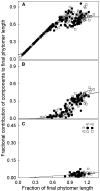Effects of nitrogen and vapour pressure deficit on phytomer growth and development in a C4 grass
- PMID: 27810947
- PMCID: PMC5206350
- DOI: 10.1093/aobpla/plw075
Effects of nitrogen and vapour pressure deficit on phytomer growth and development in a C4 grass
Abstract
Phytomers are basic morphological units of plants. Knowledge of phytomer development is essential for understanding morphological plasticity, functional-structural modelling of plant growth and the usage of leaf characteristics to indicate growth conditions at the time of production (e.g. stable isotope signals). Yet, systematic analysis on the process of phytomer development is unavailable for wild or perennial C4 grasses. Also, effects of environmental factors, such as nitrogen nutrition or vapour pressure deficit (VPD), on coordination events of developmental processes of C4 grasses have not been studied. This study investigates phytomer growth and development in Cleistogenes squarrosa, a predominant C4 grass in the Eurasian steppe, grown at low (0.63 kPa) or high (1.58 kPa) VPD with low or high nitrogen supply in controlled environments. Elongation of phytomers on marked tillers was measured daily for 13 days. Then lengths of immature and mature phytomer components (blade, sheath and internode) of all phytomers were measured following dissection. Nitrogen nutrition and VPD had no effects on coordination of growth within and between phytomers: phytomer tips emerged when phytomers reached 26 % of their final length, coincident with the acceleration phase of its elongation; blade elongation stopped when phytomers reached ∼75 % of their final length and elongation of the preceding phytomer was confined to the internode. The relationship between fraction of final phytomer length and days after tip emergence for all treatments was well described by a sigmoidal function: y = 1/{1 + exp[(1.82 - x)/1.81]}. C. squarrosa exhibited little morphological plasticity at phytomer-level in response to nitrogen supply and VPD, but a clear increase in tillering under high N supply. Also, the invariant coordination of elongation within and between phytomers was a stable developmental feature, thus the quantitative coordination rules are applicable for predicting morphological development of C. squarrosa under contrasting levels of nitrogen nutrition or VPD.
Keywords: Coordination; developmental dynamics; elongation rate; growth duration; internode; leaf appearance; leaf blade; phyllochron; plant growth model; sheath.
© The Authors 2016. Published by Oxford University Press on behalf of the Annals of Botany Company.
Figures





Similar articles
-
Bundle-sheath leakiness and intrinsic water use efficiency of a perennial C4 grass are increased at high vapour pressure deficit during growth.J Exp Bot. 2017 Jan;68(2):321-333. doi: 10.1093/jxb/erw417. Epub 2016 Nov 17. J Exp Bot. 2017. PMID: 27864539 Free PMC article.
-
An oxygen isotope chronometer for cellulose deposition: the successive leaves formed by tillers of a C4 perennial grass.Plant Cell Environ. 2017 Oct;40(10):2121-2132. doi: 10.1111/pce.13010. Epub 2017 Aug 24. Plant Cell Environ. 2017. PMID: 28644917
-
Two maize cultivars of contrasting leaf size show different leaf elongation rates with identical patterns of extension dynamics and coordination.AoB Plants. 2021 Jan 4;13(1):plaa072. doi: 10.1093/aobpla/plaa072. eCollection 2021 Feb. AoB Plants. 2021. PMID: 33604014 Free PMC article.
-
Nitrogen fertilization and δ18 O of CO2 have no effect on 18 O-enrichment of leaf water and cellulose in Cleistogenes squarrosa (C4 ) - is VPD the sole control?Plant Cell Environ. 2016 Dec;39(12):2701-2712. doi: 10.1111/pce.12824. Epub 2016 Oct 17. Plant Cell Environ. 2016. PMID: 27576868
-
Shoot branching.Annu Rev Plant Biol. 2005;56:353-74. doi: 10.1146/annurev.arplant.56.032604.144122. Annu Rev Plant Biol. 2005. PMID: 15862100 Review.
Cited by
-
Bundle-sheath leakiness and intrinsic water use efficiency of a perennial C4 grass are increased at high vapour pressure deficit during growth.J Exp Bot. 2017 Jan;68(2):321-333. doi: 10.1093/jxb/erw417. Epub 2016 Nov 17. J Exp Bot. 2017. PMID: 27864539 Free PMC article.
References
-
- Baethgen WE, Christianson CB, Lamothe AG. 1995. Nitrogen fertilizer effects on growth, grain yield, and yield components of malting barley. Field Crops Research 43:87–99.
-
- Bai Y, Wu J, Xing Q, Pan Q, Huang J, Yang D, Han X. 2008. Primary production and rain use efficiency across a precipitation gradient on the Mongolia Plateau. Ecology 89:2140–2153. - PubMed
-
- Ben Haj Salah H, Tardieu F. 1996. Quantitative analysis of the combined effects of temperature, evaporative demand and light on leaf elongation rate in well-watered field and laboratory-grown maize plants. Journal of Experimental Botany 47:1689–1698.
-
- Bloom AJ. 1985. Wild and cultivated barleys show similar affinities for mineral nitrogen. Oecologia 65:555–557. - PubMed
LinkOut - more resources
Full Text Sources
Other Literature Sources
Miscellaneous

